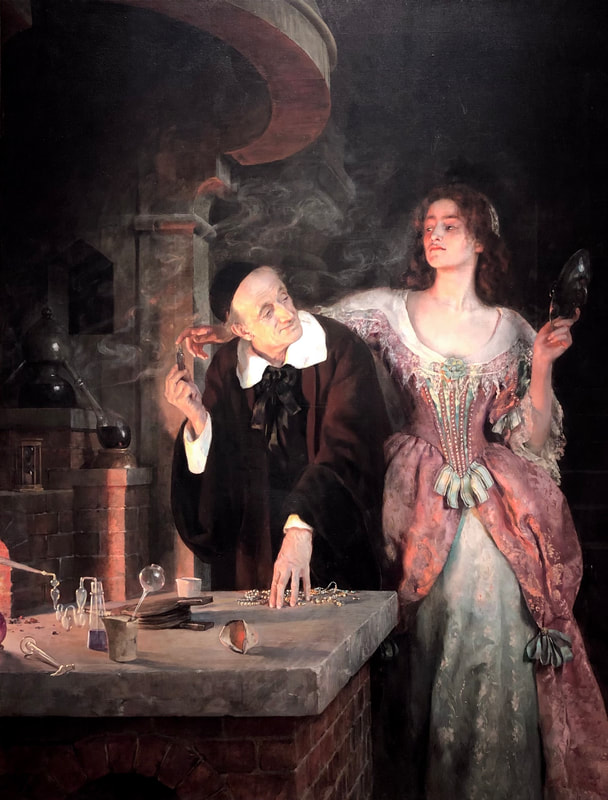The Laboratory

THE HON. JOHN COLLIER
(BRITISH, 1850-1934)
The Laboratory
signed and dated 'John Collier/95' (lower right)
oil on canvas
62 1/8 x 48 ¼ in. (157.8 x 122.6 cm.)
John Collier was frequently drawn to mythic and literary sources as inspiration for his paintings, particularly those that explored a more seductive and darker side of womanhood than what was traditionally expected of the Victorian wife and mother. These themes are present throughout his oeuvre and he frequently painted dangerous mythic and historical women including Clytemnestra, whom he depicted twice, once in 1882 (Guildhall Art Gallery, London) and again in 1914 (Worcester City Art Gallery & Museum, Worcestershire). In the present work, however, Collier has drawn from a more contemporary source, the 1844 poem by Robert Browning of the same name, The Laboratory.
Browning’s salacious and gleeful poem follows a would-be murderess as she watches an alchemist prepare a poison that will kill her husband’s lover. Here Collier captures the same sense of anticipation, depicting her impatiently reaching out for the vial of poison that will cause such destruction.
Collier portrays this transaction as shrouded in darkness and mystery. The only light source in the painting is emitted from the burning furnace, which is out of the frame to the left. The flames cast an eerie glow on the two subjects’ features, illuminating the alchemist’s sardonic smile and his customer’s beautiful yet resolute features. The smoke which coils around the center of the painting suffuses the picture with a heady atmosphere, thick with psychological tension. While Collier has chosen to render a scene where little physical drama occurs, it is still expertly laced with tension and melodrama.
The Laboratory was an immediate succès de scandale when it was first displayed at London’s New Gallery in the spring of 1895, Collier’s masterful use of light, in particular, being deemed ‘remarkable.’ The painting’s layered elements of feminine virtue, threatened by forces of darkness and evil, provided a visceral illustrative example to the resurging British interest in Gothic literature, which would reach an apex with the publication of Bram Stoker’s Dracula two years later in 1897.
Click here to download a high resolution image of The Laboratory
Provenance
Harry Coghill, J.P. (d. 1897) and Anna Louisa Walker Coghill (1836-1907), Staffordshire, before 1904.
Their estate sale; Christie's, London, 4 April 1908, lot 111.
Huggins, acquired at the above sale.
Helen H. Cowie, Rivensleigh, Dowanhill, Glasgow.
Her sale; Christie's, London, 18 May 1951, lot 37.
Asscher, acquired at the above sale.
Anonymous sale, Bukowski's, Stockholm, 4-7 April 1973, lot 140, as Laboratoriet.
Anonymous sale; Sotheby's, Belgravia, 14 June 1977, lot 153. with The Christopher Wood Gallery, London.
Acquired directly from the above in a private sale, 1984.
Acquired directly from the above by the Arts of Imagination Foundation in a private sale brokered by Christie's, New York, 2023.
Exhibited
London, The New Gallery, The Spring Exhibition, 1895.
London, The Christopher Wood Gallery, Ye Ladye Bountifulle, Images of Women and Children in Pre-Raphaelite and Victorian Art, 7-30 November 1984, no. 35, illustrated.
Literature
W. Meynell, 'A Painter of Today, The Hon. John Collier and His Work,
'The Windsor Magazine, vol. 20, June-November 1904, p. 364, illustrated. W. H. Pollock, 'The Art of the Hon. John Collier,' The Art Annual, London, 1914, p. 3, illustrated.
On the Web
Hyperallergic.com: 'The Painting of a Murderess that Scandalized Victorian Audiences'
